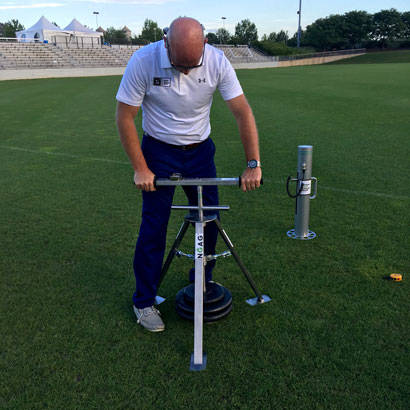
The demand for use of grass fields continues to increase; however, most field maintenance programs have not changed at all over the past 20 years. Now, with data guiding the way, older grass field maintenance programs can be updated, focusing on the following five key areas, to support their high use.
Impactful Aeration
Data analysis of grass fields often reveals that surface compaction is a constant challenge. It can start to build in high-use areas of fields within two weeks and can suffocate roots, limit soil microbial activity and slow water infiltration. Surface compaction buildup also reduces energy absorption by the surface from player impact, creating player health and safety issues.
Thankfully, data reinforces where and how surface compaction is relieved. Compaction maps of football and soccer fields highlight high-traffic areas up and down the center, while on a baseball field, the high-traffic areas are in front of dugouts and on the infield. A pull-behind slicer or PTO-driven surface aerator with solid tines can quickly and efficiently reduce compaction by opening 7–10 percent of the surface. Traditional spinning “plugger” aerators are not impactful, as they open less than 1 percent of the surface. With high-traffic areas accounting for only around half of the total field surface, aeration can take place monthly during play to offset the negatives of compaction.
Hawaii’s Maui County Parks has increased the use of, and eliminated repairs on, its football stadium since the field maintenance team, led by Lance Tokushima, started focusing on impactful aeration during football season.
Efficient Plant Feeding
Efficient plant feeding starts with impaction aeration. Spreading fertilizer on a field with a high level of surface compaction is a waste of resources. Suffocated plant roots can’t take up nutrients, and slowed microbial activity limits organic matter and fertilizer breakdown. Once compaction is relieved, plant roots and microbial activity can thrive. Yearly soil testing creates a guide for needed nutrients. Soil tests should be taken in the high-traffic areas, as the nutrient need in low-traffic areas is very different because that grass is not ever stressed.
At the Betty Wilson Soccer Complex in Nevada, Ronald Baum, City of Las Vegas Park Maintenance Field Supervisor and his team saw a reduction in repairs on fields when they focused efficient plant feeding down the field center in the high-traffic areas.
Superior Grass Selection
New varieties of Bermuda grass, Kentucky bluegrass and perennial ryegrass have been created with high-traffic fields in mind. The improved varieties have increased stress and traffic tolerance to withstand surface compaction and traffic, and they aggressively recover to fill in if there is wear. Cold tolerance in Bermuda grass has increased, as has heat tolerance of Kentucky blue and rye, and water requirements are lower, with new varieties yielding increased drought tolerance. Even if just used in the high-traffic areas, data reinforces that superior grass varieties help support increased use.
Kristi Solberg, maintenance supervisor for the City of Park Ridge Parks in Illinois, has established a strong organic fertilizer program, Now, the Park Ridge maintenance team is introducing superior grass varieties to decrease stress and increase field quality.
Proper Water Management
As soil surface compaction is reduced, water infiltration improves. Thus, on irrigated and non-irrigated fields alike, water management also starts with impactful aeration. Then deep, infrequent watering can be replaced with lighter, regular watering to hold consistent soil moisture for microbial activity and roots. Previously, it was difficult to gauge if you were drowning them with too much water or suffocating them with too little. It’s much easier now with data that can come from an individual test for soil moisture or can be gathered in real time. With water, less is always best.
The maintenance department at the City of Boca Raton Parks in Florida, led by Kevin Beckman and Wanda Harris, turned to technology to streamline its water management and dramatically decreased water use. The reduced water helped increase field quality and dramatically decreased the amount of field repairs previously required.
Easier Mowing
The importance of consistent mowing is often overlooked. Lower compaction allows superior grass varieties to respond to mowing by running sideways to fill in thin areas. Regular mowing, a minimum of twice a week, encourages these varieties to spread to increase density and durability while choking out weeds and reducing or eliminating the need to apply herbicides.
Palm Beach County Parks in Florida, led by the renovation coordination team of Gary Monnett and Gregg Irwin, increased mowing frequency and decreased mowing height and immediately saw improvement in field quality and a reduction in repairs.
Note: Data points all come from Natural Grass Performance Analytics™.
In Summary
Data provides us with a new way of looking at field maintenance, but full evolution of an old maintenance program does not happen overnight. By focusing on the preceding five areas, one by one, natural grass field quality will increase and allow for increased play with reduced repairs.
Jerad Minnick is Lead Advisor for the Natural Grass Advisory Group™.

